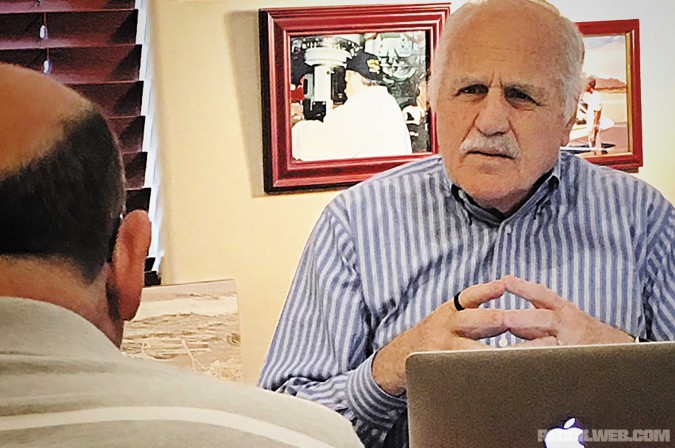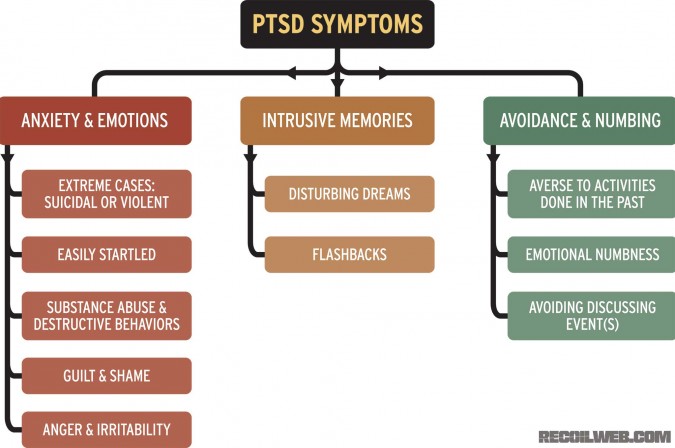PTSD Defined, Part 1
At RECOIL, we review every product fairly and without bias. Making a purchase through one of our links may earn us a small commission, and helps support independent gun reviews. Read our affiliate policy.
Find out more about how we test products.
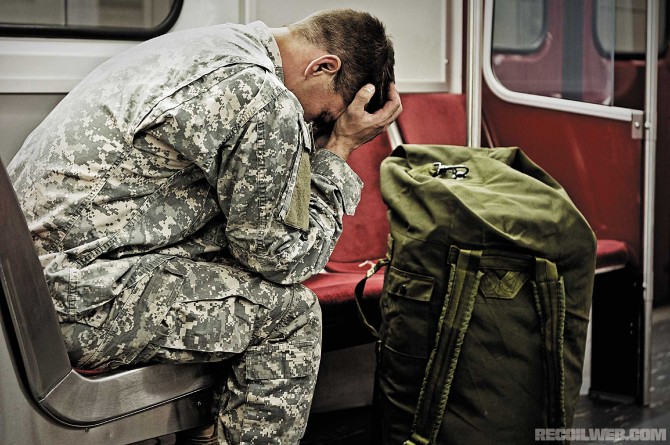
Realizing There's a Problem is the First Step to Solving it
When the trauma is great enough … the mind never forgets. Not all wounds are visible. America's combat veterans often fight silent battles day after day, and that battle is called PTSD — post-traumatic stress disorder.
In 2012, more U.S. soldiers, seamen, airmen, and Marines died by their own hands than in battle. Suicide was the No. 1 cause of death among U.S. troops that year, and Veterans Affairs (V.A.) released a suicide data report stating that an average of 22 veterans a day are killed by suicide (KBS).
Post-Traumatic Stress Disorder
Post-Traumatic Stress Disorder (PTSD) is a form of chronic psychological stress that follows exposure to a traumatic event, such as a natural disaster, a violent crime, an accident, or combat/warfare.
In his landmark book, On Combat, Lt. Col. Dave Grossman commented, “In World War I, World War II, and Korea, the number of soldiers who pulled out of the front lines because they were psychiatric casualties was greater than the number of those who died in combat.”
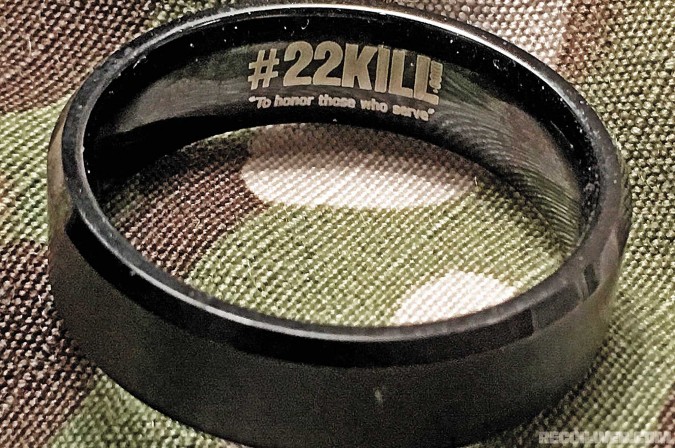
The #22KILL campaign was launched by Honor Commitment, a nonprofit that raises awareness of the 22 veterans who commit suicide each day.
The Evaluation
This was the fourth veteran evaluation that I was doing this week. He was trying to restore his composure, and with a shrug, he wiped the tears away from his face. I waited as he stared at the floor, searching for answers. He began, “Sometimes I don't know when it's going to start, but it's hard to breathe, and my heart feels like it's going to beat out of my chest. I start sweating like a pig, but my hands feel cold and numb. What's worse is that I know it's happening again, and I can't stop the thoughts and feelings. I feel like I'm falling down a well. I can't speak, but I want to scream. After, I feel exhausted, I can't think, and I want to be alone. I know that I've hurt my family big time. I don't think I'll be right again; it's like a repeating nightmare, and I'm trapped inside.”
Over my 35-plus years of practice as a psychologist, I've seen thousands of men and women who suffer from PTSD. I learned that helping these wounded people is similar to cutting a precious diamond. If I move too quickly, I might end up doing more harm than good. Unfortunately, the numbers have continued to increase, while efforts from institutions such as the V.A. hospitals appear to have fallen far behind.
Veteran's advocacy groups are on the rise and have brought the plight of the American veteran into nearly everyone's living room on a daily basis, but there still remains a significant gap between verbal commitment and actual implementation of programs (new and innovative) that are designed to help the PTSD victim.
Not all PTSD sufferers have seen combat. Veterans make up 7 percent of the American population, but account for 20 percent of its suicides. One in five veterans (nearly 300,000) who were deployed to wars in Iraq and Afghanistan have been diagnosed with PTSD.
The treatment for Iraq and Afghan veterans suffering from PTSD has cost more than $2 billion to date. Figures related to non-combat/military PTSD are difficult to obtain, but some of those affected on a regular basis are: police, firefighters, military veterans, raped and molested adults and children, battered women, and abused children. Motor vehicle accidents are a leading cause of PTSD in both men and women.
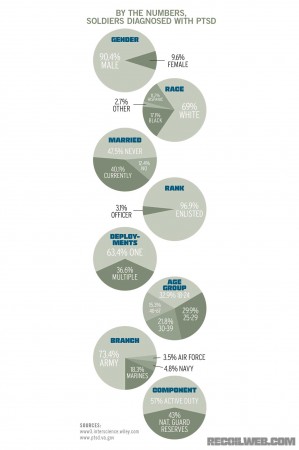
You May Be the First to Know
As a result of the mind's ability to automatically block out adverse emotions, the first person to notice the symptoms of PTSD may be a loved one or friend. Watching a one-minute blurb on television or reading about this problem in a weekly magazine does not offer enough information to initiate a discussion with a friend or loved one that they may need to seek help. You must have at least a basic knowledge of the facts regarding PTSD. Take a look at the checklist that follows and use it as a guide.
PTSD symptoms may include:
- Recurrent, intrusive dreams and memories of the trauma
- A sudden sense of recurring flashbacks
- Extreme distress when confronted with an event that resembles the trauma
- Attempting to avoid thoughts, feelings, discussions, and activities associated with the event
- Inability to remember aspects of the traumatic event
- Markedly diminished interest in previously important or pleasurable activities
- Feelings of detachment from friends or loved ones
- Low expectations for the future (no hope)
- Insomnia or excessive fatigue
- Moderate to extreme irritability
- Inability to concentrate
- Hyper vigilance (always on alert)
- Increased startle reflex to sound or touch
Diagnostic Criteria
Symptoms must last at least one month for a diagnosis of PTSD. In the acute version of the syndrome, symptoms begin within six months of the event. Chronic PTSD syndrome may be delayed in its onset until more than six months after the event. Five percent of those involved in a major natural disaster suffer enough mental distress to need treatment; the numbers are closer to 28 to 34 percent for bombings, shootings, or plane crashes. Complications of PTSD include anxiety, alcoholism or drug abuse, depression, and family or work problems.
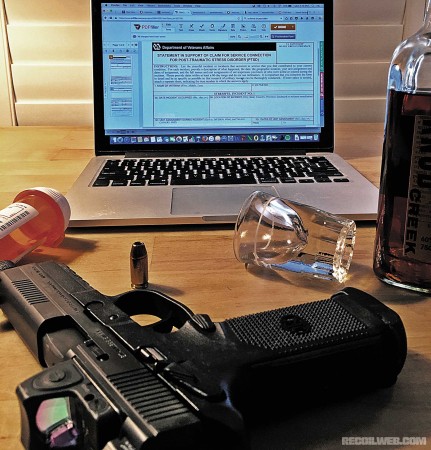
PTSD and Incarceration — The PTSD Fallout That No One Wants to Talk About
Approximately 10 percent of those who are incarcerated at any one time are estimated to be veterans. The V.A. has started a Veteran's Treatment Court for veterans to engage in active treatment for mental illness, substance abuse, or both, as an alternative to non-violent crimes instead of facing incarceration.
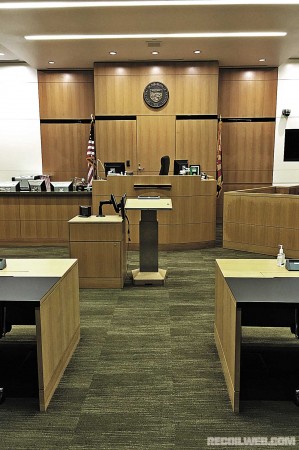
About the Author
Dr. Neal H. Olshan is the developer of Evolution of Mindset and is a consulting psychologist for corporations and the sports industry for athletic improvement through the use of his Mindset program. He is also a pilot, an award-winning photographer, an author of both fiction and nonfiction books, and the chief combat psychologist for LMS Defense.
Ask Dr. O:
Placing blame or recriminations against government agencies or organizations that have turned a blind eye to the plight of the combat veteran will only add to the frustration of the PTSD sufferer. The goal of this column is to provide a basic foundation for an understanding of PTSD. The second part of this column, coming in the next issue of RECOIL, is to provide a platform for action and commitment to make a difference. Learn how you can participate by calling your government representatives, contributing financially, or giving some of your time to those who are suffering. These men and women who put their lives at risk so that we may live the dream of democracy should never be forgotten. Civilians who suffer from PTSD could be any one of us, and we've all heard the statement, “There but for the grace of God…” Always remember that when people watch a movie such as American Sniper or any other action/war movie, no matter how intense and heart pounding the action may be, we always have the capacity to say, “It's only a movie.” For our veterans and those who suffer from PTSD, it's a real-life movie with the rerun button stuck. If you've experienced PTSD or had experience with the Veterans Administration system regarding your PTSD, please take a few minutes and let me know what your experiences have been. Part two of the PTSD series will deal with treatments, both current and future, and your input may help. Email Dr. Neal H. Olshan at mindsetdoc@gmail.com.
Veteran's Organizations
Before participating in any organization, be sure to vet it thoroughly. Since the formation of the Army, Navy, and Marine Corps in 1775, honorable men and women have fought for the freedom, safety, and ideals of our country. Since then, however, soldiers returning home have not always received the best treatment or opportunities despite their courageous military service. Fortunately, there are over 27,000 organizations supporting soldiers, veterans, and military families across the country. You can support our troops and veterans by participating in sending care packages, volunteering at a local V.A. hospital, financially supporting veteran groups, or working with a local veteran or military nonprofit.
The Dos and Don'ts of Helping Someone With PTSD
If you think a loved one or friend may be suffering from PTSD the following are dos and don'ts that have been recommended by men and women with PTSD:
- Do acknowledge that they are in pain, both emotionally and physically
- Do offer to help in any way that you can, but don't push
- Do show that you love or care about them
- Do listen without commenting or providing any critical analysis
- Do encourage them to seek help, but be patient and supportive
- Do ask if you can be of assistance researching the best help available in your particular location. Be there for them, which does not mean giving advice.
- Don't tell them, “I know just how you feel.”
- Don't try to physically restrain them if they're having a bad dream, thrashing in their sleep, or moving about while sleeping
- Don't abruptly awaken a PTSD sufferer from sleep by grabbing or yelling
- Don't ever tell them that they can “beat” the PTSD if they really want to do so
- Don't offer suggestions regarding medication based on television shows, weekly magazines, or hearsay from other people. Leave the medication to professionals.
- Don't punish them for not getting well as quickly as you think they should
- Don't force them to watch programs, movies, or documentaries about war scenes that may be upsetting to them. This may ultimately be a therapeutic treatment, however.
- Do reassure them that you care about them. Your presence may provide them with additional strength.
Why you can trust RECOIL
Since our founding in 2012, RECOIL remains the premier firearms lifestyle publication for the modern shooting enthusiast. We deliver cutting-edge coverage of guns, gear, accessories and technology. We go beyond basic reviews, providing no B.S. buyer’s guides, hands-on testing and expert analysis on everything from firearms and survival equipment to watches and vehicles.
Our reviewers are the backbone of our operation and come from diverse shooting backgrounds: Former law enforcement, military veterans, competitive shooters, seasoned hunters and plain old firearms enthusiasts. Furthermore, we’re not just gun experts, but dedicated journalists who adhere to the strictest standards of our profession.
At RECOIL, editorial independence is the foundation of everything we publish and the cornerstone of reader trust. Our editors, writers and content creators make all editorial decisions independently, free from outside influence. That boils down to: advertisers don’t dictate our coverage, the outcomes of our reviews or what we recommend in our buyer’s guides. First and always, our commitment is to our audience—ensuring every review and article is accurate, unbiased, and driven by real-world experience.
Whether you’re selecting your next firearm, upgrading your gear, or exploring the latest innovations in the shooting world, RECOIL provides the trusted insights you need to make informed decisions. Learn more about our Editorial Standards and how we review products.
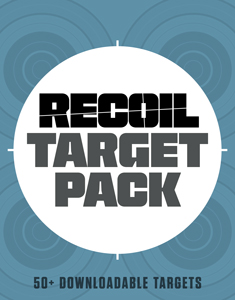
NEXT STEP: Download Your Free Target Pack from RECOIL
For years, RECOIL magazine has treated its readers to a full-size (sometimes full color!) shooting target tucked into each big issue. Now we've compiled over 50 of our most popular targets into this one digital PDF download. From handgun drills to AR-15 practice, these 50+ targets have you covered. Print off as many as you like (ammo not included).Get your pack of 50 Print-at-Home targets when you subscribe to the RECOIL email newsletter. We'll send you weekly updates on guns, gear, industry news, and special offers from leading manufacturers - your guide to the firearms lifestyle.
You want this. Trust Us.

